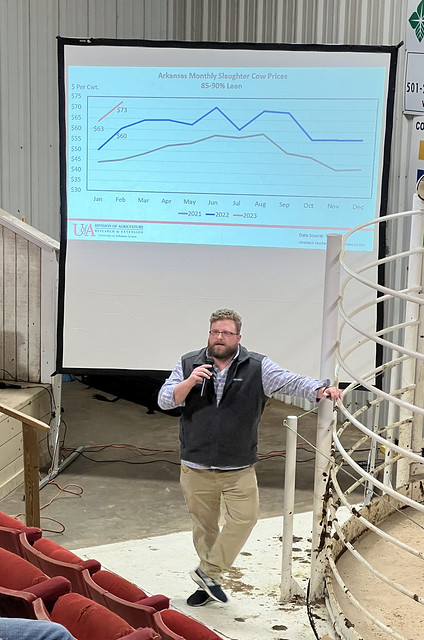Mitchell: We haven’t reached the bottom yet in U.S. cattle inventories
Mitchell noted that beef production has recovered from the pandemic’s precipitous drop in 2020 but is forecast to decline through 2023.
By Mary Hightower
U of A System Division of Agriculture
Feb 22, 2023
Fast facts
- Mitchell: Per-capita figures are misleading
- Growers need to carefully consider how they rebuild herds
(508 words)
(Newsrooms: With graphs and photo of Mitchell at https://flic.kr/s/aHBqjAt4xv )
HEBER SPRINGS, Ark. — The decline in the cattle inventory in the United States probably hasn’t hit the bottom yet, said James Mitchell, extension livestock economist for the University of Arkansas System Division of Agriculture.
Mitchell was among the presenters last Friday at the Little Red River Beef Cattle Conference at the Cleburne County Livestock Auction.
Drought during 2022 prompted many ranchers to liquidate herds, being unable to find hay to feed their cattle.
“Have we found the bottom? No,” Mitchell said. “It will be 2025 until we see any significant expansion on a national level. In terms of any national impact, we’re not done with herd liquidation. All the hay we were hoping to get did not arrive. I don’t think people are quite done selling cows.”
Mitchell noted that beef production has recovered from the pandemic’s precipitous drop in 2020 but is forecast to decline through 2023. With tighter beef production, expect beef prices to be slightly higher, he said.
“The quantity side of this is per-capita beef consumption, which is forecast at 56.3 pounds per person in 2023,” Mitchell said. That number compares with 59.2 pounds per person in 2022 and 58.8 pounds per person in 2021.
“Some are going to quote this as erosion in beef demand. This is not the case. This number is misleading. We should be calling this per-capita availability.”
Per-capita beef consumption is calculated by taking the amount of beef in cold storage, plus production, minus exports, plus exports, divided by the U.S. population.
Consumer spending on beef has not weakened. While not higher-than-$600-a-year in per-capita spending seen in 1980, consumers still spent $449 a year on beef in 2022.
Thinking about the future
Mitchell said ranchers looking to rebuild should do so carefully.
“If you’re going to buy cows — bred heifers — you’re going to need to think about prices you’ll get over the next six to seven years for her to pay for herself,” he said. “We talk about buy low, sell high. If we are buying heifers now, it’s like buying high and hope you’re selling higher.”
Retired livestock market reporter Nicky Pearson and Jerry Holmes, owner of Cleburne County Livestock Auction, conducted a session on market reports and calf grading.
“We’ve all seen the rollercoaster ride,” said Holmes, who has been in the cattle business all his life. He’s the third generation of his family to operate the livestock sales barn.
Pearson said when it comes to the sales ring, ranchers “need to sit in these seats and see what’s happening. See what’s bringing the money. See what you need to do to get the money.”
He said that calves headed to auction that have been castrated and received respiratory vaccinations do much better in terms of sales price.
“Every fall, the mismanaged cattle takes it on the chin,” he said. “The respiratory vaccinations were particularly important later in the year.
“It pays you to do it more in the fall than it does in the spring,” Pearson said. “You need to consider it when you’re marketing in October.”
Van Buren County Extension Staff Chair Danny Griffin noted that the Cooperative Extension Service has GoGreen as a preconditioning program for calves.
To learn about extension programs in Arkansas, contact your local Cooperative Extension
Service agent or visit www.uaex.uada.edu. Follow us on Twitter and Instagram at @AR_Extension. To learn more about Division
of Agriculture research, visit the Arkansas Agricultural Experiment Station website: https://aaes.uada.edu/. Follow on Twitter at @ArkAgResearch. To learn more about the Division of Agriculture,
visit https://uada.edu/. Follow us on Twitter at @AgInArk.
About the Division of Agriculture
The University of Arkansas System Division of Agriculture’s mission is to strengthen agriculture, communities, and families by connecting trusted
research to the adoption of best practices. The Division of Agriculture conducts research
and extension work within the nation’s historic land grant education system through the Agricultural Experiment Station
and the Cooperative Extension Service.
The Division of Agriculture is one of 20 entities within the University of Arkansas
System. It has offices in all 75 counties in Arkansas and faculty on five system campuses.
Pursuant to 7 CFR § 15.3, the University of Arkansas System Division of Agriculture
offers all its Extension and Research programs and services (including employment)
without regard to race, color, sex, national origin, religion, age, disability, marital
or veteran status, genetic information, sexual preference, pregnancy or any other
legally protected status, and is an equal opportunity institution.
# # #
Media contact: Mary Hightower
mhightower@uada.edu
@AgInArk

